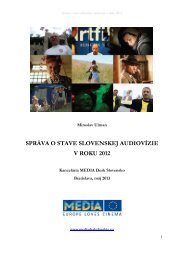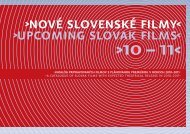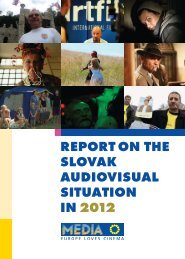Slovak Film Guide 2006 - AIC
Slovak Film Guide 2006 - AIC
Slovak Film Guide 2006 - AIC
You also want an ePaper? Increase the reach of your titles
YUMPU automatically turns print PDFs into web optimized ePapers that Google loves.
3 GENERAL INFO ON THE SLOVAK REPUBLIC<br />
� Official name: Slovenská republika (The <strong>Slovak</strong> Republic)<br />
– Parliamentary Democracy<br />
– Independent state since January 1, 1993 as one<br />
of two succession states of the former Czech and<br />
<strong>Slovak</strong> Federative Republic<br />
– Member of the European Union since May 1, 2004<br />
� Capital: Bratislava<br />
� Location: Central Europe, geographical center of Europe,<br />
bordering on the Czech Republic, Poland, Ukraine,<br />
Hungary and Austria.<br />
� Area: 49 035 square kilometers<br />
� Population: 5 384 822 (2004)<br />
Population density: 110 per sq.km<br />
� Language: official language is <strong>Slovak</strong>, following<br />
languages also are spoken in the <strong>Slovak</strong> Republic:<br />
Hungarian, Czech, Ukrainian, Romany, most members<br />
of minority ethnic groups speak <strong>Slovak</strong> in addition<br />
to their own native languages.<br />
� Currency: slovenská koruna / 100 halierov (<strong>Slovak</strong><br />
crown / 100 hellers), SKK<br />
Exchange Rate: 1 EUR = cca. 39 SKK<br />
1 USD = cca. 31 SKK<br />
� VAT rate: flat rate of 19%<br />
� GDP: 826 493 mil SKK (2004)<br />
� Time Zone: CET (Central European Time)<br />
� Dialing code: +421<br />
� Major towns:<br />
Bratislava – capital city, population: 425 155 (2004)<br />
(distances: Prague – 324 km, Vienna – 62 km,<br />
Budapest – 196 km)<br />
Košice – population 242 066 (2004)<br />
Prešov – 91767 (2004)<br />
Nitra – 85 742 (2004)<br />
Žilina – 85 268 (2004)<br />
Banská Bystrica – 81704 (2004)<br />
� Climate: moderate continental climate with cold and dry<br />
winters and hot and humid summers.<br />
6<br />
7<br />
� Terrain and Environment: The <strong>Slovak</strong> Republic<br />
is mountainous in the central and northern regions.<br />
The Carpathian Mountains extends across most<br />
of the northern and northwestern parts of the country<br />
with the highest Carpathians alpine range the High<br />
Tatras with the highest peak in the <strong>Slovak</strong> Republic<br />
Gerlachovsky Stit (2,655 meters).<br />
The southern region is dominated by the fertile Danubian<br />
lowlands.<br />
The <strong>Slovak</strong> Republic is also rich in interesting and unusual<br />
caves. Among them are the Demänovská caves, a series<br />
of caves linked by underground lakes and waterfalls,<br />
located in central <strong>Slovak</strong>ia; and the Domica cave, known<br />
for its vaulted roof and colored stalactites, located near<br />
the Hungarian border in eastern <strong>Slovak</strong>ia.<br />
The Danube is <strong>Slovak</strong>ia’s main navigable river. Other<br />
important rivers include the Vah, Hron, Eipel, Nitra,<br />
Ondava, Laborec, and Hornad. Many small glacial lakes<br />
are located in the High Tatras Mountains.<br />
The Highest Point: Gerlachovsky Stit (High Tatras)<br />
2,655 m above sea level<br />
The Lowest Point: Bodrog River (94 m above sea level)<br />
� Source: Statistical Office of the <strong>Slovak</strong> Republic<br />
www.statistics.sk, www.slovakia.org<br />
S L O V A K F I L M G U I D E 2 0 0 6










